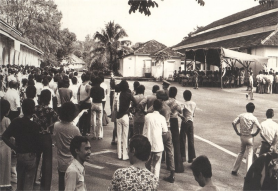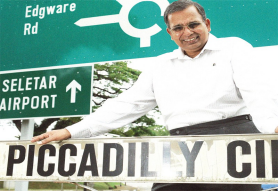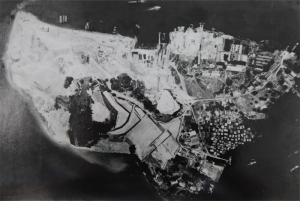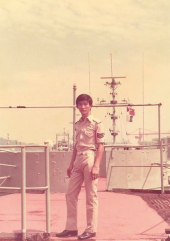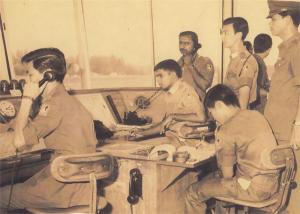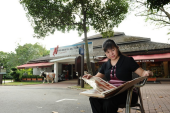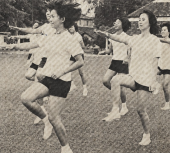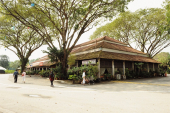OPS & TRAINING
OLD BASES, NEW FACES
04 Apr 2012

In land-scarce Singapore, quaint old places often give way to new developments. PIONEER visits three places which military personnel used to call home.
Dempsey Hill - the perfect place for a leisurely weekend brunch, and a frosty mug of beer to wind down the week. Yet, more than 20 years ago, the retail and lifestyle hub used to be where many women wept and young men stood in trepidation of things to come.
Home to the Ministry of Defence's (MINDEF's) Central Manpower Base (CMPB) from 1972 to 1989, the predecessor of Dempsey Hill - Tanglin Barracks - was where National Service enlistees were inducted into the Singapore Armed Forces (SAF).
Ms Serene Fua, a Staff Officer at the Army Information Centre, recalled a common sight during her days as a clerical assistant at the Officers' Personnel Centre (OPC): "On enlistment days, young men used to form up at the parade square next to Block 18 while waiting for 3-tonner trucks to transport them to their camps."
She continued: "Some of the mothers would cry as their sons boarded the tonners because they would not be able to see their sons for some time."
Tanglin Barracks also housed facilities such as the Registration and Recruitment Centre and Medical Classification Centre.
Since its formation in 1966, the CMPB has undergone several relocations. From its first home in Pearl's Hill Barracks, it moved to Kallang Camp followed by Tanglin Barracks, before settling down at its current home along Depot Road.
First homes
Nestled in the secluded Seletar Hills, black-and-white colonial bungalows sprawled across lush greenery stand in stark contrast to the concrete jungle of HDB estates.
"These used to be the married quarters, the residences of some of the RSAF (Republic of Singapore Air Force) personnel who worked at Seletar Air Base," Mr Menon Prasad Kumar pointed out.
The Airspace Consultant at the Air Operations Department was part of the pioneering batch of RSAF officers when a fledgling RSAF took over Seletar Air Base from the British Royal Air Force (RAF) in 1968.
He described the air base in vivid detail: "The runway divided the base into two halves, an East Camp and a West Camp. The east had recreational facilities such as shops, restaurants, cinemas and a bank, while the west contained mainly the airport facilities."
For the Navy, before it found its current homes in the east and west ends of Singapore, it was based in Pulau Brani, an island between the main island and Sentosa, from 1974 to 1999.
Said Military Expert (ME) 5 Roger Seow, a Staff Officer at the Naval Personnel Department, who was then a junior seaman on board Patrol Vessel RSS Sovereignty: "When the Navy (then Maritime Command) first moved into Brani, kampungs (villages) occupied a quarter of the island. The rest of it comprised the naval base and two graveyards."
Things past
At the old camps, significant events that took place remain fresh in the memories of the servicemen. For example, it was at Seletar Air Base that the first RSAF aircraft - a Cessna 172 - landed in 1969.
Mr Menon, who was then training to be an Air Traffic Controller, said: "That landing was memorable because that was the first time our own aircraft landed not at an RAF station, but at an RSAF airfield. Many people were in the control tower on that day to witness the landing, and I felt so proud then!"
For the sailors in the south, the opening of a 330m four-lane causeway linking Pulau Brani to the mainland in 1991 gave them reason to cheer.
ME5 Seow explained why: "Before we had the causeway, we had to take bumboats to and from Brani, and if we missed the ferry out from Brani on Friday nights, we would be stuck on the island over the weekend!"
Camps transformed
The expansion of the armed forces coupled with commercial developments necessitated the relocation of these camps.
In 2006, the old Tanglin Barracks made way for Dempsey Hill and its restaurants, bars and galleries. Despite the transformation, many of the buildings were retained and simply refurbished, and the colonial houses were preserved.
Even the names of some restaurants, such as CM-PB (Contemporary Melting Pot & Bar) and Barracks @ House hint at the history of the place.
In southern Singapore, the Navy moved out of Pulau Brani in 1999 to its new home in Tuas, and officially handed over the island to the Police Coast Guard and PSA International (formerly known as Port Authority of Singapore) in 2000.
ME5 Seow spoke about the significant shift: "We did a 'Last Sunset' ceremony on our last day, where about 200 seamen took part in a relay run. We carried the Navy flag from Pulau Brani after sunset, and timed our run such that we arrived in Tuas Naval Base in time for the morning Colours Parade before sunrise."
Today, in place of the sprawling Seletar Air Base, which vacated in 1971, are facilities such as Seletar Airport, the Singapore Youth Flying Club and Seletar Camp. Much of the area was not spared the bulldozers, as an aerospace park, estimated to be completed in 2018, is in the works.
Saying goodbye
To the pioneers, these old camps were more than mere workplaces - they were practically second homes to them. So how did they feel about the developments then?
"I felt a sense of loss," said Ms Fua. "We used to have compulsory PE (physical education) lessons once every two weeks, and that's when we would gather to march or play sports.
"After leaving Tanglin, my friends were relocated to different camps and we lost touch with one another subsequently," she added.
ME5 Roger voiced similar sentiments: "Those days, our forms of entertainment were fishing and hanging out at the mess at the hilltop, where we could see the entire island. And because we lived together, we had this kampung spirit and were very united.
"After moving from our kampung to the city, yes, there's still camaraderie, but it's nothing like what we had in the past," he said poignantly.
Mr Menon had a more positive outlook: "In a way, the developments have helped us to preserve the aviation aspect at Seletar. Now that there's the aerospace park coming up and companies like Rolls-Royce coming in, it's a matter of great pride for all of us."
He ended by saying: "So I have no regrets. It's part of how we evolve, isn't it?"
ALSO READ IN OPS & TRAINING

Exercise Wallaby 2025: To see better, shoot faster
31 Oct 2025
The SAF focuses on complex strike missions and multi-domain integration in Exercise Wallaby 2025, the 35th edition of its largest unilateral overseas exercise.

Ex Wallaby 25 – Greater Integration and Complexity
25 Oct 2025
The 35th edition of the SAF’s largest unilateral overseas exercise is an opportunity for expanded scale and deeper integration towards an effective, networked fighting force.

Ex Forging Sabre ramps up use of unmanned assets in integrated strike operations
12 Sep 2025
In this 10th edition of Exercise Forging Sabre, the SAF sharpened its cutting edge for the dynamic modern battlefield, with expanded integration between manned and unmanned platforms.


